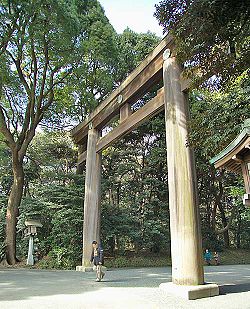- Meiji Shrine
-
Meiji Shrine
明治神宮
Torii leading to the Meiji Shrine complex Information Type Imperial Shrine Dedicated to Emperor Meiji
Empress ShokenFounded November 1, 1920 Address 1-1, Kamizono-chō
Yoyogi, Shibuya-ku
Tokyo 151-0053Phone +81 (03) 3379-5511 Website Homepage Meiji Shrine (明治神宮 Meiji Jingū), located in Shibuya, Tokyo, is the Shinto shrine that is dedicated to the deified spirits of Emperor Meiji and his wife, Empress Shōken.[1][2]
Contents
History
After the emperor's death in 1912, the Japanese Diet passed a resolution to commemorate his role in the Meiji Restoration. An iris garden in an area of Tokyo where Emperor Meiji and Empress Shōken had been known to visit was chosen as the building's location.
Construction began in 1915, and the shrine was built in the traditional nagare-zukuri style and is made up primarily of Japanese cypress and copper. It was formally dedicated in 1920, completed in 1921, and its grounds officially finished by 1926.[3] Until 1946, the Meiji Shrine was officially designated one of the Kanpei-taisha (官幣大社), meaning that it stood in the first rank of government supported shrines.[4]
The original building was destroyed during the Tokyo air raids of World War II. The present iteration of the shrine was funded through a public fund raising effort and completed in October, 1958.[5]
Meiji Shrine was brought into the flow of current events with the 2009 visit of United States Secretary of State Hillary Clinton. After arriving in Tokyo on her first foreign trip representing the newly elected President Barack Obama, she made her way to this shrine in advance of meetings with Japan's leaders to show her "respect toward history and the culture of Japan."[6]
In January 2010, German Foreign Minister Guido Westerwelle demonstrated the same respect when he concluded his visit to Japan with a visit of the shrine.[7]
Shrine complex
Meiji Shrine is located in a forest that covers an area of 700,000 square-meters (about 175 acres). This area is covered by an evergreen forest that consists of 120,000 trees of 365 different species, which were donated by people from all parts of Japan when the shrine was established. The forest is visited by many as a recreation and relaxation area in the center of Tokyo.[2] The shrine itself is composed of two major areas:
Naien
The Naien is the inner precinct, which is centered on the shrine buildings and includes a treasure museum that houses articles of the Emperor and Empress. The treasure museum is built in the Azekurazukuri style.
Gaien
The Gaien is the outer precinct, which includes the Meiji Memorial Picture Gallery that houses a collection of 80 large murals illustrative of the events in the lives of the Emperor and his consort. It also includes a variety of sports facilities, including the National Stadium, and is seen as the center of Japanese sports[citation needed]. It also includes the Meiji Memorial Hall, which was originally used for governmental meetings, including discussions surrounding the drafting of the Meiji Constitution in the late 19th century. Today it is used for Shinto weddings.
Image gallery
-
Barrels of sake (nihonshu) donated to the Meiji Shrine
-
Another view of the torii at the entrance to Meiji-jingu
-
Meiji Shrine with Yoyogi park
See also
- Meiji Jingu Stadium
- List of Shinto shrines
- List of Jingū
Notes
- ^ "Meiji Shrine". http://www.japan-guide.com/e/e3002.html. Retrieved 2008-03-22.
- ^ a b "Introduction". Archived from the original on 2008-03-11. http://web.archive.org/web/20080311165144/http://www.meijijingu.or.jp/english/intro/index.htm. Retrieved 2008-03-22.
- ^ "Meiji Shrine". Encarta. Microsoft. Archived from the original on 2009-11-01. http://www.webcitation.org/5kx7DD0qV. Retrieved 2008-03-22.
- ^ Ponsonby-Fane, Richard. (1959). The Imperial House of Japan, pp. 126.
- ^ "Shrine Building". Archived from the original on 2008-03-11. http://web.archive.org/web/20080311165139/http://www.meijijingu.or.jp/english/intro/building/index.htm. Retrieved 2008-03-22.
- ^ "Clinton visits Tokyo shrine," Hindustani Times. February 17, 2009.
- ^ http://www.auswaertiges-amt.de/diplo/en/AAmt/BM-Reisen/2010/01-JapanChina/100114-japan.html
References
- Ponsonby-Fane, Richard Arthur Brabazon. (1959). The Imperial House of Japan. Kyoto: Ponsonby Memorial Society. OCLC 194887
External links
- Official English site Requires Flash.
- Meiji Shrine English map
- Meiji Shrine Panorama
Coordinates: 35°40′34″N 139°41′57″E / 35.67611°N 139.69917°E
Shinto shrine Shinto architecture Buildings - chōzuya or temizuya
- haiden
- heiden
- hokora
- honden / shinden / shōden
- kagura-den
- massha
- sessha
Architectonic elements Styles - hirairi-zukuri
- tsumairi-zukuri
- gongen-zukuri
- hachiman-zukuri
- hiyoshi-zukuri
- irimoya-zukuri
- ishi-no-ma-zukuri
- kasuga-zukuri
- kibitsu-zukuri
- misedana-zukuri
- nagare-zukuri
- ōtori-zukuri
- owari-zukuri
- ryōnagare-zukuri
- shinmei-zukuri
- sumiyoshi-zukuri
- taisha-zukuri
Others Implements Main kami Staff Head shrines1 - Fushimi Inari Taisha
- Usa Hachiman-gū
- Ise Grand Shrine
- Dazaifu Tenman-gū
- Munakata Taisha
- Suwa Taisha
- Hiyoshi Taisha
- Kumano Nachi Taisha
- Tsushima Shrine
- Yasaka Shrine
Miscellaneous 1 (in order of the size of the shrine network they head)
Categories:- Jingū
- 1920 establishments in Japan
- Religious buildings completed in 1958
- Shibuya, Tokyo
- Shinto shrines in Tokyo
Wikimedia Foundation. 2010.









